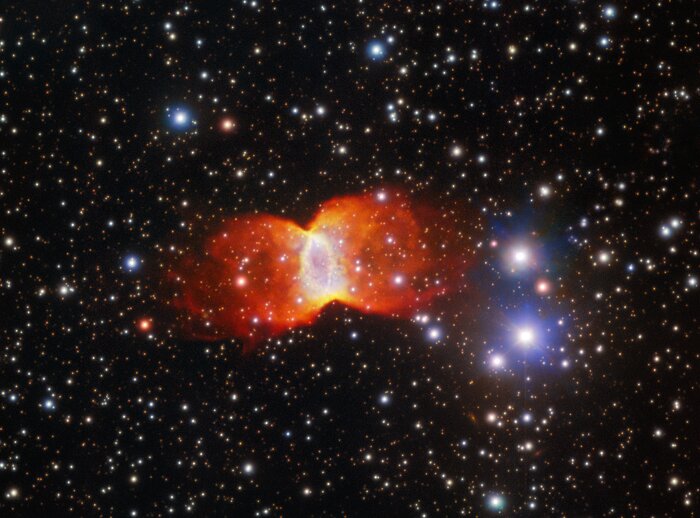A ‘Butterfly’ from Death’s Door
This ghostly, butterfly-shaped planetary nebula, captured with Gemini North, one half of the International Gemini Observatory, supported in part by the U.S. National Science Foundation and operated by NSF NOIRLab, is known as Kohoutek 3-46. Kohoutek 3-46 derives its name from the prolific planetary nebula hunter who discovered it, Czech astronomer Luboš Kohoutek.
Located in the constellation Cygnus, Kohoutek 3-46 is estimated to be around 20,000 years old and around 7200 light-years away. The term ‘planetary nebula’ is a misnomer, since these nebulae are unrelated to planets. The term originates from their planet-like round shape, more obviously seen in this earlier NOIRLab Image of the Week. Kohoutek 3-46 has expanded into an unusual bipolar shape, classified by its well-defined hourglass shape, prominent equatorial ring and marked waist. About 10–20% of planetary nebulae are bipolar. No matter the shape they take on, these glowing clouds of gas form after a star of one to eight times the mass of the Sun has expanded into a red giant. As the core of the red giant contracts, the star expels layers of its atmosphere into space. Energetic ultraviolet radiation from the hot, exposed core then ionizes this gaseous shell around it, ‘illuminating’ the planetary nebula.
Credit:International Gemini Observatory/NOIRLab/NSF/AURA
Image processing: J. Miller (International Gemini Observatory/NSF NOIRLab), M. Rodriguez (International Gemini Observatory/NSF NOIRLab) & M. Zamani (NSF NOIRLab)
About the Image
| Id: | iotw2430a |
| Type: | Observation |
| Release date: | July 24, 2024, noon |
| Size: | 1781 x 1317 px |
About the Object
| Name: | PN K 3-46 |
| Distance: | 7200 light years |
| Constellation: | Cygnus |
| Category: | Nebulae |
Wallpapers
Coordinates
| Position (RA): | 19 49 59.20 |
| Position (Dec): | 33° 45' 55.21" |
| Field of view: | 4.80 x 3.55 arcminutes |
| Orientation: | North is 0.0° left of vertical |
Colors & filters
| Band | Wave-length | Tele-scope |
|---|---|---|
| Optical OIII | 499 nm | Gemini North GMOS-N |
| Optical SII | 672 nm | Gemini North GMOS-N |
| Optical H-alpha | 656 nm | Gemini North GMOS-N |

